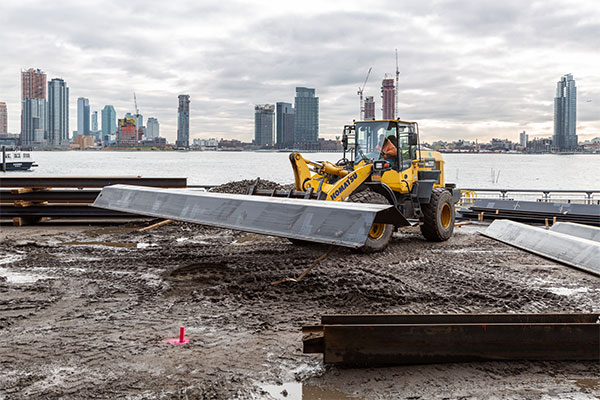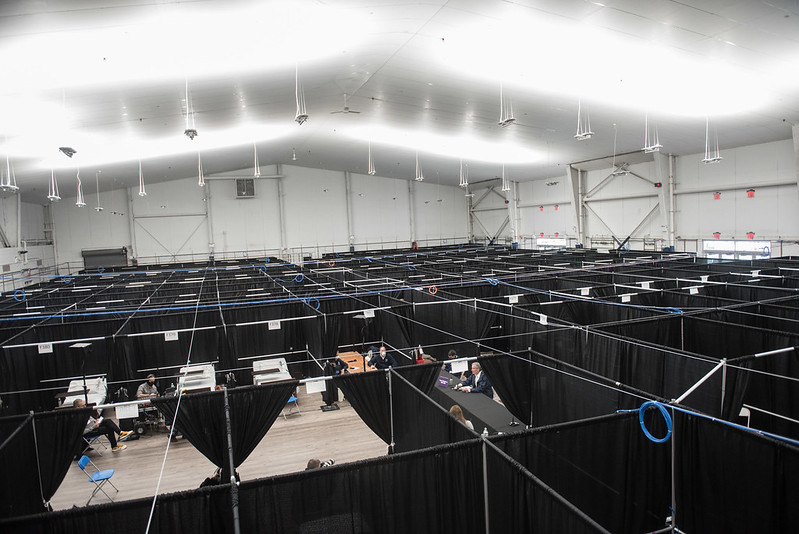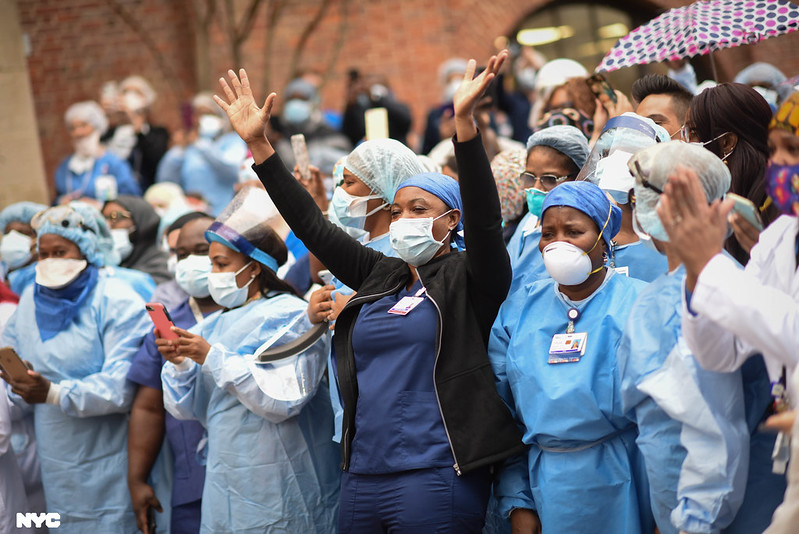Building a Climate Safe Future for Manhattan’s East Side

Starting the ESCR work (photo: NYC Department of Design and Construction)
When Hurricane Sandy slammed into New York City—killing 44 New Yorkers and causing $19 billion in damages—it instantly became clear that preparing for stronger storms and rising seas had to become a top priority for our city’s future.
City officials worked across agencies to draw up bold new plans for fortifying our shoreline, with a special focus on those areas that were hardest hit by Sandy. Since then, New York City has invested $20 billion to increase our resiliency to flooding and extreme heat, far outpacing the efforts of any other United States city.
This week, we’re celebrating a major milestone for our climate adaptation efforts as construction crews begin pile-driving for the East Side Coastal Resiliency project. This project will transform 2.4 miles of Manhattan’s waterfront from Montgomery Street to East 25th Street and is considered one of the most ambitious and complex climate adaptation projects anywhere in the world.
ESCR will directly protect more than 110,000 New Yorkers and improve waterfront open spaces in a racially diverse area that has one of the highest concentrations of public housing in the country. This area endured major damage from Sandy: 94% of residents lost power; homes and subway tunnels flooded; and grocery stores, pharmacies, and other essential businesses were closed for days on end.
Around the world, most climate adaptation projects have typically consisted of tide gates constructed in harbors or rivers, far from the communities they’re responsible for protecting. ESCR is different. The constraints posed by Manhattan’s density and geography led us to develop a bold project that will seamlessly traverse an area packed with housing and businesses, dotted with parks, and crisscrossed with subway lines, busy streets, underground utilities, and a major highway.
Catalyzed by hundreds of millions of federal disaster recovery dollars and supplemented by City funds, this project will install new protections and park improvements that will repel floodwaters from future Sandy-like storms for generations to come. Our world-renowned team of planners, architects, and engineers created an innovative design that uses raised parkland, floodwalls, berms, and movable floodgates to create a continuous line of defense.
A raised East River Park is the project’s centerpiece. This park is more than just a line of defense against storms. It’s the crown jewel of Manhattan’s east side; a place where generations of New Yorkers can work, play, and live.
To ensure that we didn’t wall the community off from their waterfront, we focused on creating better access, with new, universally-accessible pedestrian bridges that will create more inviting and inclusive points of entry. The park’s Robert Moses-era design has also been reimagined and improved to include new features and amenities sought by the community, such as new open gathering spaces and step-down areas where visitors can access the East River’s shore.
At the same time, we are making sure that beloved features like ballfields, tennis courts, exercise areas, and a track and field will return with stronger materials and resilient design. We have also meticulously phased construction so that nearly half of East River Park will remain open at all times. These choices directly reflect the voices we heard during our multi-year community engagement process, which involved more than one hundred public meetings, events, and other gatherings.
Cities can’t adapt to climate change overnight. And as long as the world remains addicted to fossil fuels, we’re forced to take aim at a moving target.
The start of this project, however, should offer New Yorkers hope and reassurance. We anticipate that the project will be fully complete by 2025, providing a much-needed sense of security to a neighborhood that’s as populous as the entire city of Albany. We may not be able to prevent the next big storm from coming—but we can act today to prevent damage and bounce back faster than ever.
The threats posed by global warming and extreme weather may be daunting, but New York City won’t back down. We will continue to build our resilience with a mix of creativity, grit, and innovation. New Yorkers deserve nothing less.
***
Jainey Bavishi is the Director of the NYC Mayor’s Office of Resiliency. On Twitt er @jaineytweets & @NYCMayorsOffice.
***
Have an op-ed idea or submission for Gotham Gazette? Email This email address is being protected from spambots. You need JavaScript enabled to view it.
We Must Support Research to Help Combat Long-Haul COVID-19 and the Next Pandemic

Taking on covid (photo: Michael Appleton/Mayoral Photography Office)
By now, every New Yorker knows someone who has been infected with COVID-19 or has had it themselves. Since the start of this pandemic, over 800,000 New York City residents have had a positive test. And a year into the fight against this disease, we know that the battle is far from over, as New Yorkers grapple with the effects of long -haul COVID: respiratory issues, brain fog, heart palpitations, and depression. We need more research and more data to learn more about the long-term impacts of COVID-19 and its impact on New Yorkers. That’s why we are pledging our support for this research when we are elected Manhattan Borough President and to the City Council, and fighting to advance it now.
In the aftermath of the 9/11 attacks, we all saw how first responders and the people living and working in the vicinity of the World Trade Center developed health issues ranging from COPD to depression to cancer. That’s why New York created a voluntary registry for survivors to help track and research long-term health conditions arising from the attacks. Working off that model, Senator Hoylman has already proposed legislation to create a voluntary registry run by the New York State Department of Health to track the long-term physical and mental health impacts of the disease — but more can be done.
New York City was the epicenter of this disease, but is also home to world-class hospitals and universities that are already engaged in groundbreaking research on COVID-19. When elected, we will work to provide additional funds for research into long-haul COVID, partner with public hospitals, and cut intergovernmental red tape. We are seeing that New York innovation now in our public university system: SUNY Downstate Medical Center in Brooklyn was converted into a COVID-only hospital and The City College of New York’s work to create a new vaccine.
In our respective prospective roles as Borough President and City Council member, we want to be champions of STEM education and the best way to do that is by supporting research. For all of the tragedies we encountered over the last year, we also have seen breakthroughs in scientific research. Within 10 days of the virus being first detected, its DNA sequence was made available online. Because of the groundwork research being laid for mRNA vaccines in the preceding years, we had vaccine trials beginning just months after the virus arrived.
Our city must do whatever it can to combat the long-term effects of coronavirus. We know it has disproportionately hurt our most vulnerable communities: those that are low-income, those in communities of color, those with underlying conditions. As public servants, we want to do our part to make our society more equitable so the next time a deadly virus emerges, we will be ready. Once elected to these new roles, we are committed to investing in the research and partnerships needed to fight the long term effects of this pandemic — and any future pandemics — for years to come.
***
State Senator Brad Hoylman is a candidate for Manhattan Borough President and Briget Rein is a candidate for City Council in Brooklyn’s 39th District. On Twitter @BradHoylman & @briget4brooklyn.
***
Have an op-ed idea or submission for Gotham Gazette? Email This email address is being protected from spambots. You need JavaScript enabled to view it.
Toward a New Post-Covid Normal: Time to Get Serious About Health Equity

Hospital staff (photo: Michael Appleton/Mayoral Photography Office)
The new director of the Centers for Disease Prevention and Control said the quiet part out loud last week – racism infects our public health system.
“What we know is this: racism is a serious public health threat that directly affects the well-being of millions of Americans,” Dr. Rochelle P. Walensky, the CDC director, said, citing disparities and inequities long-known to those of us who work to increase access to quality, affordable health care in Black and brown communities.
Dr. Walensky was blunt in her honesty, saying the COVID-19 pandemic had “revealed for all Americans a known, but often unaddressed, epidemic impacting public health: racism.”
It is especially gratifying to hear her words now during what has been designated Minority Health Month. We have seen as the pandemic took its toll in lives and health across the country that the highest percentages of disease and death occurred in vulnerable communities where disproportionate numbers of minorities live, where essential workers live, and where chronic diseases such as diabetes, hypertension, obesity, asthma, and kidney disease afflict residents far more than in the overall population.
And it is why we cannot have as our goal coming out of the pandemic to return to ‘normal.’ We know what that normal was, and it’s the result of structural barriers that limit access to everything from fresh produce to safe streets to educational opportunity and, of course, to access to the quality, affordable health care that must be a right for all.
Our goal has to be a new normal, where holis tic approaches to health care replace the disjointed and unequal system under which the color of your skin or the zip code you lived in determined your opportunity to access that quality care.
It includes requiring, among other things, public and private insurance plans to cover mental health care, tackling the environmental racism that sees polluting infrastructure such as asthma-causing bus garages sited in poor neighborhoods, and jump-starting the scandalously slow removal of lead paint from public housing buildings, which stunts the educational and life potential of so many children.
For those of us across the country at Black Health, the organization I head, the pandemic brought us into contact with thousands of vulnerable residents through test and tracing programs early in the pandemic, and confronting vaccine hesitancy in the current phase. We learned that it takes trusted local voices – pastors, community leaders, educators, and others – to reach people where they are to press upon them the urgency of the moment in trying to defeat this greatest public health threat in our lives.
But we cannot stop at vaccines, as clearly essential as they are in trying to move beyond the moment of public health threats. It is more than the urgency of now. We have to turn it into the opportunity of now.
We are encouraged that the new administration in Washington, D.C., as evidenced by the long-overdue words of Dr. Walensky, has moved to separate access to health care from a person’s ability to pay. Expanding coverage under the Affordable Care Act to include a public option that can drive down the cost of health insurance is a critical, albeit insufficient step towards that goal.
Breaking the grip of the “sickness industry” – the interlocking financial interests of hospitals, drug companies, and the like – requires aggressive support through funding of preventive programs. It is no surprise that Medicaid, the primary funder of state-managed health coverage for the poor, will cover $50,000 to $60,000 per year for diabetes-related dialysis – a $35 billion a year business, with squads of lobbyists protecting their financial interests over the interests of sick patients – but will not cover the estimated $900 per patient for evidence-based, peer-education programs that help vulnerable residents drive down their blood sugar levels.
And studies have shown as the pandemic has progressed that blood sugar levels are directly correlated with higher complications and death rates for those with chronic diseases such as diabetes who contract COVID.
People don’t have to be that sick but under the “old normal,” far too often they were. And until we recognize the role that racism has played in skewing the public health system across the nation, we cannot create the “new normal” we need and deserve.
As we continue the struggle to conquer COVID-19, we can no longer ignore the social virus of racism. We stand with Dr. Walensky in her acknowledgement of what should be obvious to anyone paying attention. And we will hold her at her word as we work to rid the health system, and society at large, of that racist virus.
***
C. Virginia Fields is the Founder and CEO of Black Health - the National Black Leadership Commission on Health. On Twitter @CVirginiaFields.
***
Have an op-ed idea or submission for Gotham Gazette? Email This email address is being protected from spambots. You need JavaScript enabled to view it.




